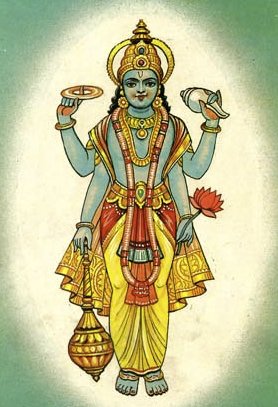Kuticaka, Kuṭīcaka, Kuti-caka: 11 definitions
Introduction:
Kuticaka means something in Hinduism, Sanskrit. If you want to know the exact meaning, history, etymology or English translation of this term then check out the descriptions on this page. Add your comment or reference to a book if you want to contribute to this summary article.
Alternative spellings of this word include Kutichaka.
In Hinduism
Vaishnavism (Vaishava dharma)
Source: ISKCON Press: GlossaryKuṭīcaka (कुटीचक).—The first stage of the sannyāsa order. The kuṭīcaka lives in a hut nearby his village, and his family brings him food.

Vaishnava (वैष्णव, vaiṣṇava) or vaishnavism (vaiṣṇavism) represents a tradition of Hinduism worshipping Vishnu as the supreme Lord. Similar to the Shaktism and Shaivism traditions, Vaishnavism also developed as an individual movement, famous for its exposition of the dashavatara (‘ten avatars of Vishnu’).
Purana and Itihasa (epic history)
Source: Cologne Digital Sanskrit Dictionaries: The Purana IndexKuṭīcaka (कुटीचक).—A class of ascetics.*
- * Bhāgavata-purāṇa III. 12. 43.

The Purana (पुराण, purāṇas) refers to Sanskrit literature preserving ancient India’s vast cultural history, including historical legends, religious ceremonies, various arts and sciences. The eighteen mahapuranas total over 400,000 shlokas (metrical couplets) and date to at least several centuries BCE.
Shaivism (Shaiva philosophy)
Source: DSpace at Pondicherry: Siddha Cult in Tamilnadu (shaivism)Kuṭīcaka (कुटीचक).—According to the ancient tradition, ascetics who strive to gain liberation are classified into four classes. They are kuṭīcakas, bahūdakas, haṃsas and paramahaṃsas. Of these, the last represents an extremely ancient ascetic order.

Shaiva (शैव, śaiva) or Shaivism (śaivism) represents a tradition of Hinduism worshiping Shiva as the supreme being. Closely related to Shaktism, Shaiva literature includes a range of scriptures, including Tantras, while the root of this tradition may be traced back to the ancient Vedas.
Languages of India and abroad
Sanskrit dictionary
Source: DDSA: The practical Sanskrit-English dictionaryKuṭīcaka (कुटीचक).—a religious mendicant of a particular order; चतुर्विधाभिक्षवस्ते कुटीचकबहूदकौ । हंसः परमहंसश्च यो यः पश्चात् स उत्तमः (caturvidhābhikṣavaste kuṭīcakabahūdakau | haṃsaḥ paramahaṃsaśca yo yaḥ paścāt sa uttamaḥ) || Mb.; Bhāgavata 3.12.42.
Derivable forms: kuṭīcakaḥ (कुटीचकः).
Kuṭīcaka is a Sanskrit compound consisting of the terms kuṭī and caka (चक).
Source: Cologne Digital Sanskrit Dictionaries: Shabda-Sagara Sanskrit-English DictionaryKuṭīcaka (कुटीचक).—m.
(-kaḥ) One who lives at his son’s expense.
Source: Cologne Digital Sanskrit Dictionaries: Benfey Sanskrit-English DictionaryKuṭīcaka (कुटीचक).—[kuṭī-cak + a], m. A class of religious mendicants, [Bhāgavata-Purāṇa, (ed. Burnouf.)] 3, 12, 43.
Source: Cologne Digital Sanskrit Dictionaries: Monier-Williams Sanskrit-English DictionaryKuṭīcaka (कुटीचक):—[=kuṭī-caka] [from kuṭī > kuṭ] m. ‘delighting in staying in the house’, a kind of religious mendicant (who lives at his son’s expense), [Mahābhārata xiii, 6478; Bhāgavata-purāṇa iii, 12, 43.]
Source: Cologne Digital Sanskrit Dictionaries: Yates Sanskrit-English DictionaryKuṭīcaka (कुटीचक):—(kaḥ) 1. m. One who lives at his son’s expense.
[Sanskrit to German]
Sanskrit, also spelled संस्कृतम् (saṃskṛtam), is an ancient language of India commonly seen as the grandmother of the Indo-European language family (even English!). Closely allied with Prakrit and Pali, Sanskrit is more exhaustive in both grammar and terms and has the most extensive collection of literature in the world, greatly surpassing its sister-languages Greek and Latin.
Kannada-English dictionary
Source: Alar: Kannada-English corpusKuṭīcaka (ಕುಟೀಚಕ):—
1) [noun] a mendicant who, after renunciation of his worldly attachments, stays with his son but without involving in any worldly affairs.
2) [noun] a wanderer, finally settled at a place.
Kannada is a Dravidian language (as opposed to the Indo-European language family) mainly spoken in the southwestern region of India.
See also (Relevant definitions)
Starts with: Kuticakam, Kuticakan.
Full-text: Kutiraka, Bahudaka, Kuticakam, Paramahamsa, Hamsa, Putrannada, Bahyudaka.
Relevant text
Search found 9 books and stories containing Kuticaka, Kuti-caka, Kuṭī-caka, Kuṭīcaka; (plurals include: Kuticakas, cakas, Kuṭīcakas). You can also click to the full overview containing English textual excerpts. Below are direct links for the most relevant articles:
Chandogya Upanishad (Madhva commentary) (by Srisa Chandra Vasu)
The Skanda Purana (by G. V. Tagare)
Chapter 23 - Duties of Forest-Hermits (Vānaprastha) and Recluses (Saṃnyāsa) < [Section 9 - Vāsudeva-māhātmya]
Chapter 1 - The Birth of the Liṅga < [Section 1 - Tīrtha-māhātmya]
Chaitanya Bhagavata (by Bhumipati Dāsa)
Verse 1.8.96 < [Chapter 8 - The Disappearance of Jagannātha Miśra]
Thirty minor Upanishads (by K. Narayanasvami Aiyar)
Puranic encyclopaedia (by Vettam Mani)
The Agni Purana (by N. Gangadharan)
Related products
